We may receive a commission when you use our affiliate links. However, this does not impact our recommendations.
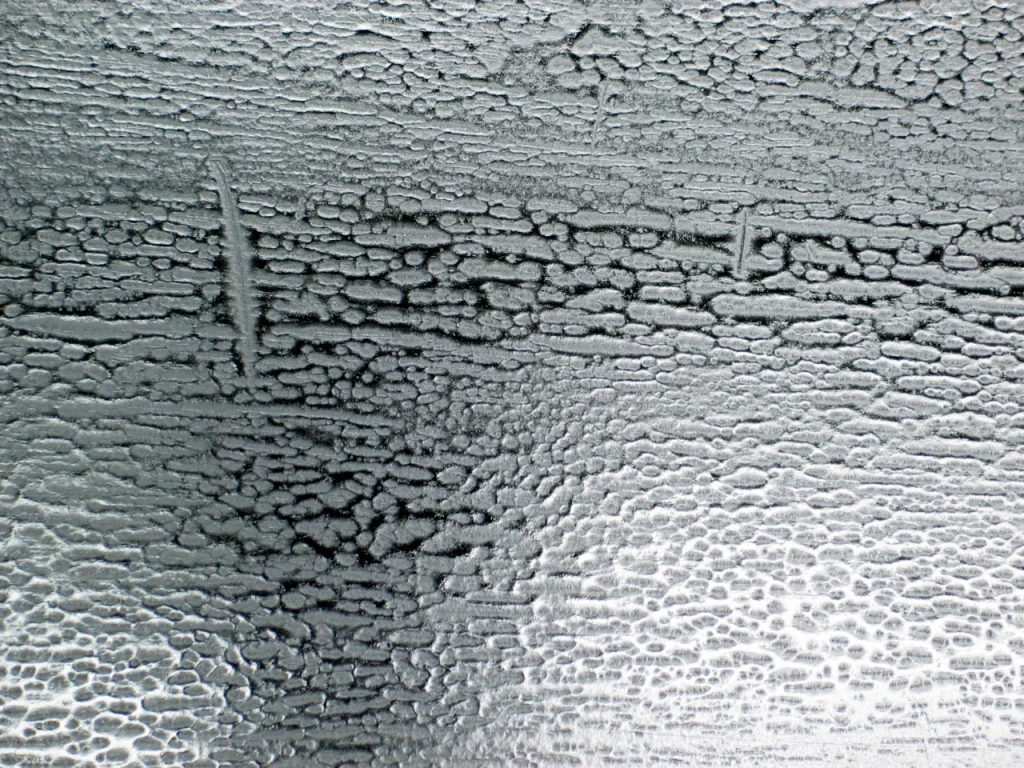
This is a really bad case of fish eye in a colored lacquer finish. When this happens, you can actually see the finish crawling into ridges.
In my last posting on May 2, I mentioned that furniture polishes containing silicone have a bad reputation. Nevertheless, they are very popular with consumers. I thought I should go into a little more explanation for this seeming contradiction, and also address some of the questions I got.
Back in the 1970s, when I started my furniture making and restoration shop, one of the first things I learned from suppliers and other refinishers was that Pledge furniture polish was bad for furniture and I should discourage people from using it.
The culprit in Pledge was (and is) silicone oil, which is usually called “silicone” or “silicones.”
Silicone oil was supposedly responsible for all sorts of problems, some contradictory, including softening finishes, causing them to become brittle and crack and even scratching finishes (confusing silicone with silicon from which it’s made). I’ve even heard that “silicones” cause splits in the wood. The terms “silicone” and “silicones” can sound a little ominous and have no real meaning to most of us, so it was easy to assign all sorts of bad qualities to them.
After a few years I began to question the bad reputation because I saw so many tabletops that had been dusted with Pledge for decades and still looked great. (Pledge had about a 60% market share at the time so lots of people were using it.) The finish wasn’t soft or cracked, and there wasn’t an abnormal amount of scratching. I began thinking that this badmouthing of Pledge must be motivated by the difficulties refinishers have applying new finishes to furniture that had been treated with a silicone containing furniture polish.
The problem was that if any of the silicone oil had gotten into the wood through the old finish, usually through cracks or crazing, the newly applied finish crawls up into ridges, often in the shape of small craters or the eyes of fish, hence the name “fish eye” to describe it. Refinishers hate this problem because so few understand it or how to deal with it. When it happens, it seriously reduces the profit that should have been made. But refinishers couldn’t say, “Stop using Pledge because it makes my job of refinishing harder,” so other problems had to be made up, believed and spread.
With this background, I realized that I needed to learn more about silicone.
It’s actually an oil, similar to mineral oil but much slicker. You can easily feel the difference if you put a drop or two of each between your thumb and forefinger and rub them together. Because the terms “silicone” and “silicones” don’t reflect that this is actually an oil, which can be removed the same way any oil can, I began calling it “silicone oil” to make it clearer what we were dealing with.
Besides its slickness, synthetically derived silicone oil doesn’t break down at very high temperatures as do other oils, so it is better than mineral oil or motor oil for lubricating machinery that runs very hot. It also reduces scratches better than other oils, because of its slickness, and it gives wood (through the clear finish) a deeper and richer look than mineral oil or furniture polishes based solely on petroleum-distillate solvents.
It’s not just Pledge that contains silicone oil. Many furniture polishes do, especially those in aerosols.
Also important, the small amount of silicone oil in many furniture polishes, not just Pledge, evaporates far slower than the petroleum distillates in lemon-oil or other polishes, so people learned from each other and from cleaning people that they could keep their tabletops looking great for a week or two with the silicone furniture polishes.
Almost all cleaning people have learned that it pays to use a silicone containing furniture polish because without the silicone oil, the polish evaporates before the client returns home from work, so there’s little evidence that any work had been done.
Maybe most important in this context, silicone oil is totally inert. It doesn’t damage anything.
On the negative side, silicone oil can leave a smear if the excess isn’t all wiped off, so it’s important to do this.
Because of its advantages, silicone-oil-containing polishes have almost the entire market share, so I quickly determined that it was a waste of time trying to talk people out of using these polishes. Instead, I devoted myself to teaching methods of dealing with the fish-eye problem when refinishing.
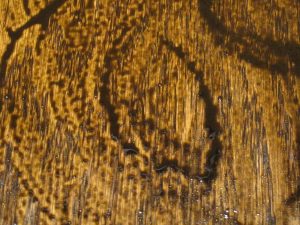
You can usually tell you’re going to have a fish-eye problem in your finish when you apply a wet coat of stain.
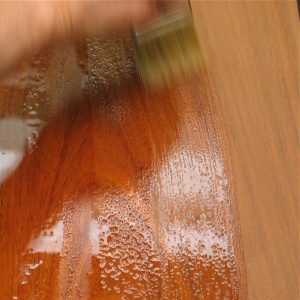
If you’re not staining, brush a wet coat of mineral spirits (paint thinner) on the surface. You’ll see if there’s going to be a problem.
Here are the three easiest ways:
Clean the oil out of the wood before beginning to apply a finish.
There are two ways to do this. One is to wash the wood several times with a petroleum-distillate solvent and wipe off the excess after each wetting. It’ll help to turn the cloth a lot, and you could use acetone, but it evaporates very fast, so you’ll need to move fast. You’ll slowly thin the oil and lift it off the wood until there’s not enough oil left in the wood to cause a problem. The other method is to wash the wood with a strong alkali such as TSP, ammonia or lye. The alkali will destroy the oil. But, of course, it may also darken the wood and raise the grain, and these chemicals can be rather dangerous to work with. So I prefer the first method.
Block off the oil in the wood with a first coat of shellac.
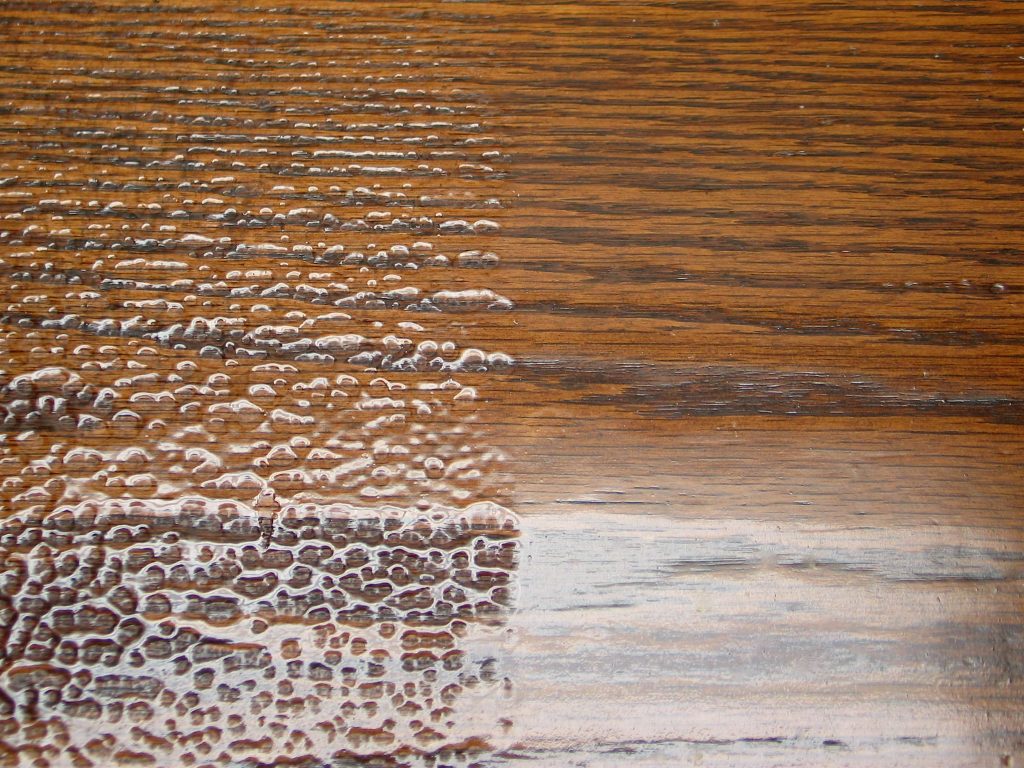
A first coat of shellac (right half) is usually effective at blocking the silicone oil in the wood so it can’t affect the finish.
You can continue with more coats of shellac, of course, or you can switch to another finish once you have the wood well sealed.
Add silicone oil to your finish.
This will reduce the surface tension of the finish enough so the new finish flows out without ridging. Once you have added the silicone oil, which you can buy from many suppliers, you have to continue adding the silicone oil to each subsequent coat. Search for “fish-eye flow out,” “fish-eye eliminator,” or “Smoothie” online to find suppliers.
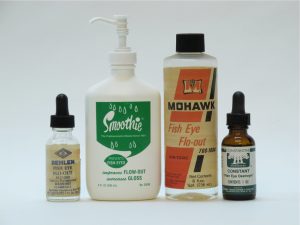
There are many sources for fish-eye eliminator. Look online to find some near you or by mail order.
Begin by adding an eye-dropper full to about a quart of finish and adjust from there depending on the contamination. For water-based finishes, add an emulsified silicone oil from a supplier of water-based finishes.
You can imagine that the contamination in the wood can vary. I’ve known some people, for example, who applied a silicone-oil polish to unfinished wood for years to give it a little shine. In situations like this, you’re going to have to work very hard to get a good finish on this wood. You may very well have to use all three techniques.
I’ve gone through periods in my shop when I’ve sealed everything with shellac before spraying lacquer, or when I’ve added “fish-eye eliminator” to all my lacquer coats, whether I knew there was a problem or not just to ensure there wouldn’t be. I’ve known many other refinishers who have done the same.
In the end, it’s up to the refinisher, whether professional or amateur, to know how to deal with the fish-eye problem. It’s a hopeless task to try to get people to stop using these polishes.
Here are some supplies and tools we find essential in our everyday work around the shop. We may receive a commission from sales referred by our links; however, we have carefully selected these products for their usefulness and quality.









This is fantastic! I inherited a dresser a number of years ago and had set about trying to repair the badly chipped finish. After careful sanding and staining to match the surrounding area, no matter what I did I had horrible fish eye problems. This was from a Pledge household, and I now know without a doubt what my problem was! Thank you for a most illuminating article.
Another excellent and informative post. Thank you.
In the early 1990s, I worked for a supplier of architectural grade pedestrian door closers. One of the big three auto suppliers was building a new painting facility and wanted to ensure that absolutely no silicone materials were present in the building. The auto manufacturer had determined that silicone contamination was causing problems with paint adherence to the cars. We had to certify that no silicones were present in the materials or finish of the products supplied — this was difficult as silicon was used in the springs ( really should not have been a problem) and silicone was in the hydraulic oil in the standard products ( that was a problem.). But we did find products that met the requirements.
When I worked at the Johnson Space Center years ago, we got an alert about wearing the rubber-band bracelets that were popular then. Remember the ones that memorialized something or someone? The caution was that we should not wear them if we were working around spacecraft parts, because the silicone oil could transfer from our skin to the parts, and reduce the effectiveness of our high-tech adhesives and coatings. I would not be surprised to find that some of our woodworking adhesives are affected by silicone oil contamination.
Thanks for bringing this up!